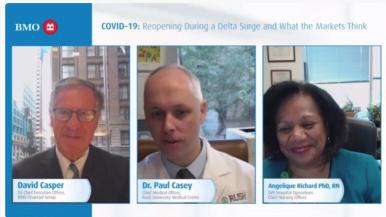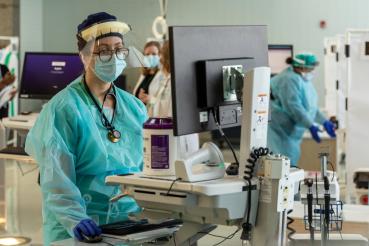Rush University Medical Center leaders joined BMO economic and market experts to take measure of how the latest wave of the COVID-19 pandemic is impacting health, markets and the economy.
Moderated by BMO Financial Group U.S. Chief Executive Officer David Casper, the panel featured Rush leaders Paul Casey, MD, MBA, chief medical officer, Rush University Medical Center, and Angelique Richard, PhD, RN, senior vice president of hospital operations for the Medical Center and chief nursing officer for the Medical Center and Rush University System for Health. They were joined by BMO Capital Markets Chief Investment Strategist Brian Belski and Head of FICC Macro Strategy Margaret Kerins, who discussed the pandemic's impact on the economy and markets,
“We have a great balance of expertise on this call,” Casper said as he opened the event, noting recent partnerships between BMO and Rush. “BMO and Rush have been partnering in a few different ways of late, including the recent launch of the Rush BMO Institute for Health Equity, and it's great to see our partnership continue to grow.”
Delta surge
At the time of the panel, there were still well more than 100,000 daily cases and more than 2,000 daily deaths rom COVID-19 occurring nationwide. Yet even as the Delta variant continues to surge through the United States, Casey said medical authorities are beginning to see a “downward” slope in infections, an encouraging sign — though the coronavirus has been inherently unpredictable.
With only 55 percent of eligible Americans fully vaccinated for COVID-19, there’s a direct correlation between hot spots for the virus and the rate of vaccinations. “When one looks at the map of hot spots throughout the country or places where there are still cases, it’s really inversely proportionate to the vaccination rate in those areas,” Casey said.
Much of that gap comes amid continued vaccine hesitancy, and Richard said a combination of fear, lack of information, myths and untruths about both the virus and the vaccine, and mistrust of the U.S. health care system, are all to blame.
The consequences of hesitancy, Richard continued, are not just an increase in cases, but an increase in deaths from the virus and multi-faceted impacts on health care.
“It’s at a crisis level,” she said. “There are limited bed capacities and workforce deficits, there's been a strain on the financial viability of many health care organizations and their performance, and then there's just the access and limitation, again that many health care organizations have either gone through or are going through, for patients with non-COVID health care needs.”
Turning to vaccination mandates in businesses, Richards said organizations need to be able to make decisions, and to communicate them more efficiently to employees.
“Courageous leadership is needed now more than ever,” she said, urging business leaders to take the time to understand, listen to, and educate employees who are troubled by vaccines.
A grassroots approach, incorporating partnerships with key trusted individuals and community leaders who can help spearhead campaigns or reach out personally, are just a few of the ways to better reach staff. “Make it personal,” said Richard.
The experts also addressed the debate around long-term COVID-19 and the symptoms that can persist after the initial infection has run its course. The science is still emerging about what is known as “long hauler syndrome,” Casey said, but there are a number of symptoms he is seeing throughout the hospital system: persistent cough, significant fatigue, brain fog or a decrease in cognitive function, and headaches.
“We've had a few young, very healthy 30-year-old individuals that say they can barely walk from their car into work,” he said, noting that these types of ongoing symptoms are rare for other types of common illnesses.
The economy: faith in the market bull
Turning to the economy, Belski said the resilience demonstrated by the Canadian and U.S. economies, underscoring their ability to pivot as a society and as a marketplace in the face of the pandemic, are what assure him that we are still only halfway through a 25-year bull market that started in 2009.
“I have faith in the U.S. economy and stock market, and faith in the Canadian economy and stock market, and that's what has kept us so bullish,” he said in his opening remarks. “It really speaks to the strength of the United States stock market and our companies, and to the Canadian stock market and our companies, and we have to start believing that.”
Referencing inflation fears and recent signals from the U.S. Federal Reserve that it will begin tapering its asset purchases before the end of the year, Belski maintained his view that inflation woes are transitory, likely lasting a quarter or two, and that he does not expect interest rate hikes until well into next year.
The Canada value proposition
Pointing to current forecasts for 5% GDP growth in Canada and 5.8 percent growth in the United States, Belski said many investors are missing the value proposition of Canadian markets, which he said are set to outpace their U.S. counterparts on the back of “epic” company earnings and cash flow.
“And so, we think Canada is going to continue to outpace the U.S., I think, for the fourth quarter, and well into 2022, with the great financial companies, or the great material companies, great consumer discretionary companies and industrials, and those areas will continue, I think, to outperform,” he said. “We are overweight the same sectors in the United States.”
Belski recommended a balanced approach to investing in both markets, being equal growth and value.
With respect to a three- to five-year outlook, he said, “We continue to believe that the stock market is going to be achieving 13 to 15 percent compound annual growth over the next five years, if not 10 years, and our favorite sectors by far are technology, communication services, and discretionary.”
FICC and Fed rhetoric
Kerins said that while she remains in the “inflation is transitory” camp, a change in Fed rhetoric around tapering is already being priced into the market as something that will come sooner rather than later.
Recent messaging from the Fed has indicated it is “not willing to let inflation run hot for too long,” Kerins said. This comes a week after the Fed’s September meeting, where it reinforced that the bar for tapering asset purchases had been met for inflation, and was just about met for employment.
She said the most recent change in tone would likely see a taper as soon as November or December, when the Fed will decrease purchases by $15 billion per month. Kerins expects the taper likely would be followed by interest rate hikes late next year.
“In terms of a Fed taper, that ship is sailing,” she said, but that does not mean economic growth will grind to a halt. “The way that we’re thinking about tapering is as a reduction in the tailwind pushing the economy forward,” said Kerins. “When the Fed does start to tighten, it does in fact become a headwind.”
Based on longer-term demographic trends and technological changes in the economy that will continue to weigh on employment, Kerins said that even when rates do start to rise, they will likely remain relatively low on a historical basis.
The environment will continue to evolve, however, and with it, Fed thinking, said Kerins. Upcoming changes in the composition of the Federal Reserve Board, for example, might see it behave more dovish, and maybe even push off tightening until 2023.
“A year is a long time in the markets, even for forecasts, so the data has to evolve as the Fed expects, in order for them to lift off,” she said.
Kerins said that next year will see a record amount of Treasury coupons available to the private markets — some $2 trillion compared to $1.8 trillion in 2021 and negative $443 billion in 2020 — but she forecast heavy issuance will be met with strong global demand against the backdrop of virus variants.
While COVID-19 continues to overshadow our road to recovery, there are reasons for “cautious” optimism. Optimism is warranted, the Rush medical experts on the panel said, because of how far we’ve come in the past 18 months in terms of understanding this virus, but it is cautious because every new infection is another opportunity for the virus to mutate into something more serious.
Said Casey: “This isn’t a U.S. effort or Canadian effort. It’s a global effort to really get the vaccine levels to where they need to be in order to prevent more variants.”
“It is a tough time, it's challenging for all of us as business leaders,” Casper said to wrap up the event. “We want to get this economy continuing to move in the right direction."
To view the panel discussion, visit this link.




